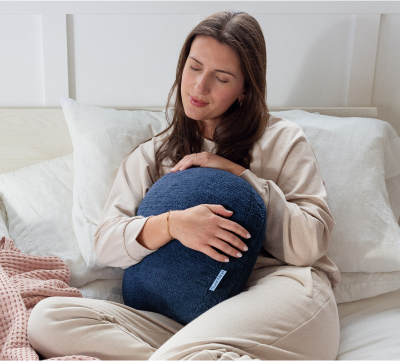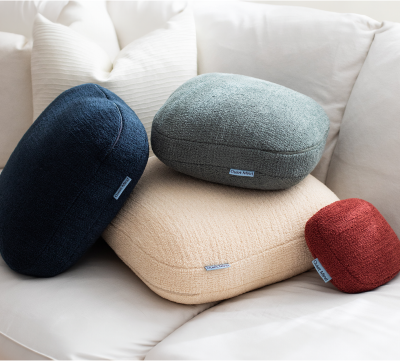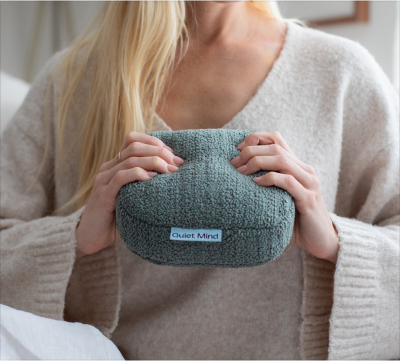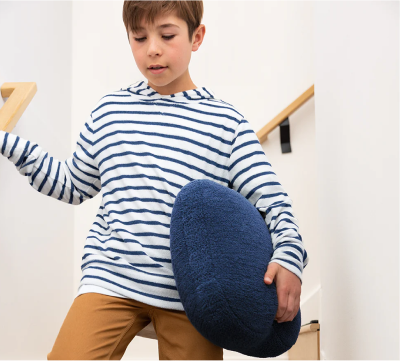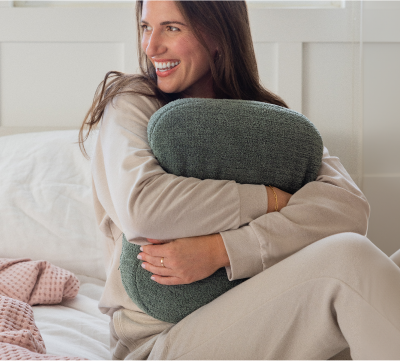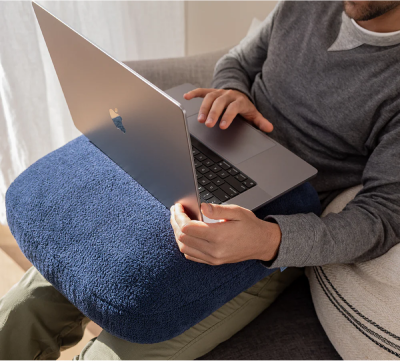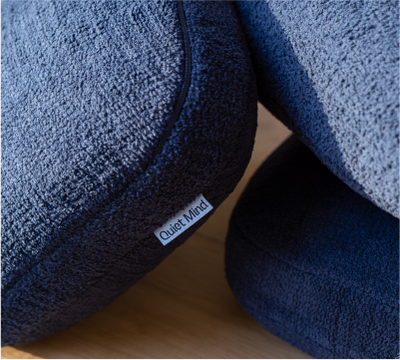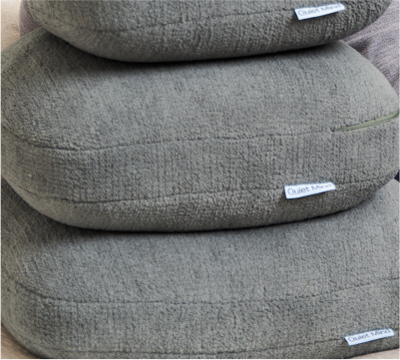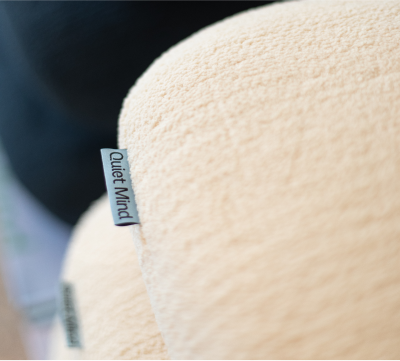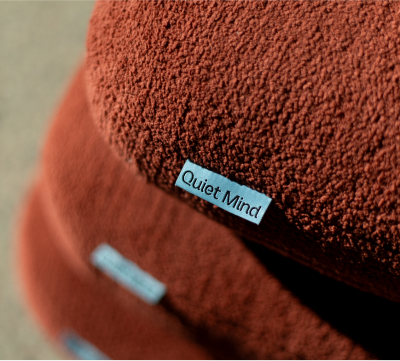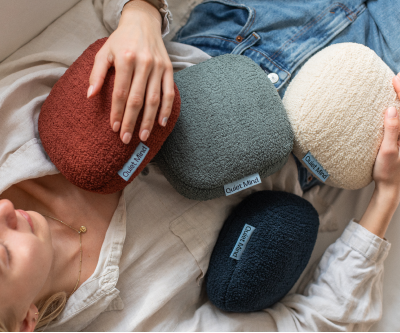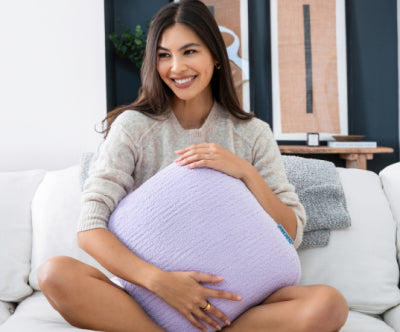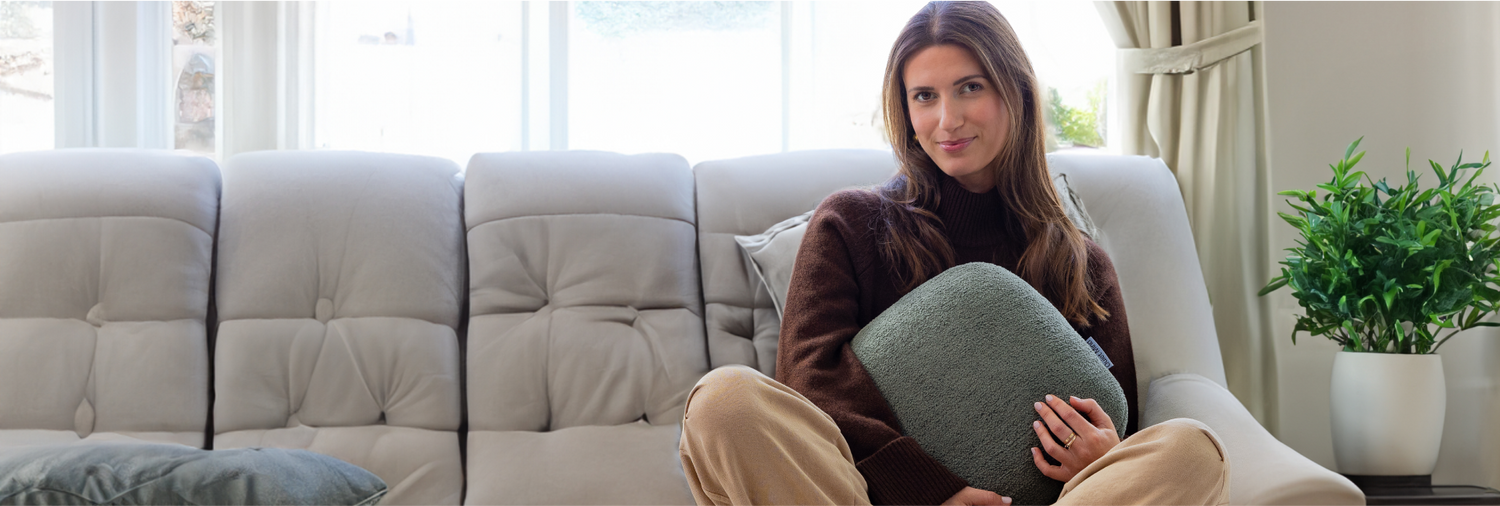Anxiety doesn't always roar. Sometimes, it creeps in softly; tight shoulders, restless sleep, or thoughts that won’t stop looping. You may not even realize how overwhelmed you feel until your body sends the message through tension, fatigue, or irritability.
In these moments, fast relief matters. And not just any relief; something gentle, grounded, and easy to reach. Whether you live with generalized anxiety disorder, experience occasional panic attacks, or are simply moving through high stress levels, there are ways to reduce anxiety that don’t involve pushing through or pretending you’re fine.
This guide shares practical, science-informed, and sensory-friendly ways to relieve anxiety symptoms quickly while building trust in your body’s ability to return to calm.
Why Anxiety Can Feel So Overwhelming So Quickly
Anxiety symptoms often involve a mix of physical, emotional, and cognitive reactions. Your heart races. Your chest feels tight. Your thoughts move too fast to follow.
This is the body’s stress response in action, activated by the amygdala and fueled by stress hormones like cortisol and adrenaline. These reactions once helped us escape danger. Today, they often respond to less visible threats: deadlines, social pressures, or unresolved fears.
Some signs of an anxiety disorder or anxiety and depression overlap:
|
Symptom |
Description |
Common Impact |
|
Racing thoughts |
Repetitive, intrusive worries |
Makes it hard to sleep or focus |
|
Increased heart rate |
Physical panic response |
Creates a sense of alarm |
|
Muscle tension |
Body held in defense |
Can cause pain, fatigue |
|
Irritability |
Low frustration tolerance |
Affects relationships |
|
Sleep disturbance |
Lying awake at night |
Reduces mental and physical recovery |
For people with anxiety, these symptoms can be distressing; but they’re not permanent. Fast-acting tools can help you soothe your anxiety quickly and bring the body back into balance.
Fast-Acting Techniques to Calm Anxiety in the Moment
When your nervous system is activated, you don’t need to do something big. You need something effective, simple, and soothing. These approaches are natural ways to interrupt the cycle of anxious thoughts and reconnect to the present.
Deep Breathing
Slow, intentional breathing is one of the most effective ways to reduce anxiety quickly. It directly influences the parasympathetic nervous system.
Try this pattern:
- Inhale through your nose for 4 counts
- Hold for 4
- Exhale through your mouth for 4
- Pause for 4
- Repeat for 3–5 rounds
This pattern, known as box breathing, may help reduce physical symptoms like a fast heart rate and send calming signals to the brain.
The 3-3-3 Rule
The 3-3-3 rule for anxiety helps manage racing thoughts by anchoring your awareness:
- Name 3 things you can see.
- Identify 3 sounds you hear.
- Move 3 parts of your body (e.g., toes, fingers, shoulders).
It’s quick, discreet, and grounding, ideal for both public and private spaces.
Cold Water Reset
Sudden cold exposure can interrupt the brain’s panic response by activating the mammalian dive reflex:
- Splash cold water on your face.
- Hold an ice cube.
- Rinse your wrists with cool water.
These physical sensations can help break the loop of panic and bring a sense of calm.
Natural Remedies That Provide Quick Anxiety Relief
Gentle, sensory-based tools can support nervous system regulation. While they are not a substitute for treatment for anxiety or behavioral therapy, they often help reduce anxiety symptoms in the moment.
Calming Herbs and Supplements
- Chamomile may ease stress and anxiety through its calming compounds.
- Magnesium supports muscle relaxation and nervous system repair.
- L-theanine (found in green tea) promotes calm alertness.
Certain drinks can help relieve anxiety when infused with these calming ingredients, offering a gentle way to support your nervous system. Since water also helps with anxiety by keeping the body hydrated and supporting overall brain function, it serves as a natural base for many soothing beverages. Always consult a health professional before starting any new supplement, especially if you have existing health conditions.
Aromatherapy
Scent is powerful. It bypasses logic and speaks directly to the emotional centers of the brain, often triggering feelings of safety, calm, or emotional release.
- Lavender is widely used to ease anxiety, support sleep, and calm the nervous system.
- Bergamot has shown promise in improving mood and lowering stress hormones like cortisol.
You can use essential oils in a diffuser, apply them to your wrists or temples, or keep an inhaler stick nearby for quick, on-the-go grounding.
At Quiet Mind, our scented weighted pillows bring these elements together, blending gentle pressure with calming aromas to soothe the senses and support deeper relaxation.
Physical Techniques That Relieve Anxiety Fast
Anxiety often lives in your muscles, posture, and breath, long before it reaches your thoughts. Physical movement, stillness, or intentional pressure can help discharge that energy and create a noticeable shift in your state of mind.
When your nervous system is in a state of high alert, simple body-based techniques can begin the process of calming the fight-or-flight response. These practices help reconnect your mind and body, reduce physical symptoms like restlessness or tension, and bring you into the present.
Progressive Muscle Relaxation (PMR)
Progressive Muscle Relaxation is a gentle practice that guides the body out of tension and into safety. It's especially helpful during panic attacks, at bedtime, or when you feel emotionally overloaded but don’t have words.
How to Practice PMR:
- Start at your feet: squeeze your toes tightly for 5 seconds.
- Release slowly as you exhale, noticing the shift in sensation.
- Continue up the body: calves, thighs, stomach, hands, arms, shoulders, face.
- Focus on the contrast between tension and release.
Doing this consistently may help reduce anxiety and panic symptoms, improve body awareness, and support emotional regulation. PMR is often used in therapy for anxiety and can become a reliable self-soothing tool over time.
Gentle Stretching or Movement
Even subtle movements can activate your body’s calming systems. Stretching releases muscle tightness, improves circulation, and sends the message that you’re not stuck in a threat response.
Try:
- Shoulder rolls to release upper body stress.
- Gentle neck stretches to reduce jaw or spine tension.
- Reaching your arms overhead with a deep breath.
- A walk around the block to reset mental and emotional rhythm.
Movement doesn’t need to be intense to be powerful. A few slow, mindful gestures can lower stress levels, improve oxygen flow, and help you feel more in control of your body.
Mental Distraction and Focus Shifts to Calm the Mind
When you're caught in a spiral of anxious thoughts, it can feel impossible to redirect your mind. But the brain is trainable and small shifts in focus can interrupt negative thinking patterns, soothe emotional distress, and improve mental clarity.
Cognitive Reframes and Guided Imagery
These tools help you soften the emotional charge of anxiety by offering a new lens or visual experience. They are especially useful when fear or self-doubt feels overpowering.
Try:
- Visualizing a peaceful place that feels safe and nurturing.
- Repeating self-soothing mantras like: “This is temporary.”, “I’ve felt this before, and I made it through.”, “My body knows how to come back to calm.”
Over time, this gentle form of cognitive therapy may help increase emotional resilience and reduce the frequency or severity of anxious episodes. Visualization is often used in CBT for anxiety and helps reinforce feelings of safety.
Distraction with Intention
Intentional distraction isn’t avoidance, it’s a strategy to give your overwhelmed brain something constructive to do. These tools work well when your thoughts are looping or when you need to feel grounded fast.
Here are some ideas you can try to relieve anxiety quickly:
- Count backward from 100 by 7s or 3s.
- Do a sensory scan: name what you can smell, see, hear, taste, and touch.
- Play a quick mental game like a word association or shape-matching puzzle.
These techniques engage the logical part of your brain and can interrupt racing thoughts, allowing your emotional system to slow down and reset.
What Works Best for Anxiety in Public vs Private?
The tools that feel safe or appropriate often depend on your surroundings. When you're at home, you may have space to stretch out, cry, or lie down. In public, the goal is often discretion and portability.
Creating a toolkit for both settings allows you to manage anxiety wherever it arises, without shame, pressure, or overwhelm.
|
Tool |
Public Setting |
Private Setting |
|
Deep breathing |
Yes |
Yes |
|
Aromatherapy |
Discreet roll-on, inhaler stick |
Room diffuser, essential oil bath |
|
Stretching |
Small shoulder or neck rolls |
Full-body yoga or somatic movement |
|
Progressive Muscle Relaxation |
Seated micro-tensing |
Guided audio with body scan |
There’s no “right” way to relieve anxiety. Some people find quiet grounding most helpful, while others need movement or sensory input. Trust what feels doable, and make space for different needs in different places.
How to Create an Anxiety SOS Plan
Anxiety can feel unpredictable, but having a plan in place reduces panic and increases your sense of agency. Your SOS plan doesn’t need to be complicated. It just needs to work for you.
The goal is to make calm more accessible, especially in moments when your nervous system feels flooded or unresponsive.
Step 1: Identify Your Triggers
Start by noticing what precedes your anxiety spikes. This helps you respond early—sometimes even before symptoms begin.
Keep a journal or notes on your phone:
- What time of day does anxiety tend to show up?
- Are there common environments or social dynamics involved?
- What thought patterns tend to make you spiral?
Understanding your personal patterns helps you create preventative strategies, not just reactions.
Step 2: Choose 3–5 Reliable Coping Tools
Your coping toolkit should be portable, familiar, and soothing, not complicated or unfamiliar.
|
Tool |
Usefulness |
|
Deep breathing pattern |
High – accessible anywhere |
|
Weighted support (like a QuietMind pillow) |
High – provides sensory grounding |
|
Guided imagery or mantras |
High – reinforces emotional safety |
|
Stretching or mindful walking |
Moderate to high – resets energy flow |
|
Music or calming sound app |
Moderate – helps regulate mood |
|
Water (sipping or splashing) |
Moderate – helps calm the nervous system and support hydration |
Keep these tools where you can reach them: your bag, nightstand, car, or desk drawer.
The QuietMind weighted pillow is one such tool. It offers deep, even pressure that supports your body’s natural calming responses, especially when placed across your lap, chest, or shoulders during stressful moments.
Step 3: Prepare Your Support Network
You don’t have to navigate anxiety alone. Having support in place makes it easier to reach out when needed.
- Let a trusted friend or partner know what helps you during anxious moments.
- Consider regular sessions with a mental health professional who specializes in anxiety disorders.
- Save key support numbers like a crisis line or text-based support service in your phone.
Support doesn’t have to mean talking, it just means knowing you’re not alone in your experience.
Fast Anxiety Relief vs Root Cause Support
Quick tools matter but lasting calm comes from healing the root.
|
Approach |
Immediate Relief |
Long-Term Support |
|
Methods |
Breathwork, grounding, physical tools |
Therapy, lifestyle shifts, nervous system repair |
|
Benefits |
Fast regulation, reduced overwhelm |
Sustainable calm, deeper resilience |
|
Examples |
3-3-3 Rule, muscle relaxation, apps |
CBT, EMDR, somatic work, trauma-informed care |
A layered approach, fast tools for now, deeper support for later is often the most sustainable.
The Role of Therapy in Anxiety Management
Therapy provides more than just coping strategies, it offers a space to explore the roots of anxiety, including unresolved stress, unprocessed emotions, and long-standing patterns. While therapy isn’t a quick fix, it can help you relax your anxiety in moments of overwhelm by teaching tools to regulate your thoughts and nervous system.
Approaches like cognitive-behavioral therapy (CBT), somatic therapies, and trauma-informed care have shown strong results in helping people understand, manage, and move through anxiety.
Therapists don’t hand you the answers, they walk alongside you as you uncover your own, offering support, insight, and a path back to inner steadiness.
Digital Tools and Apps That Help With Fast Anxiety Relief
Technology can be overwhelming, but it can also be a lifeline. Mental health apps are becoming increasingly supportive, offering science-backed techniques for breathing, meditation, sleep, and anxiety relief.
These tools are ideal when you need calm in your pocket or a structured way to shift your state.
Meditation and Breathing Apps
These apps guide your nervous system out of stress with mindfulness, visualization, and breath regulation:
- Headspace: Clear visuals and easy breathing programs for beginners.
- Calm: Meditation, sleep stories, nature sounds, and daily reminders.
- Insight Timer: Thousands of free meditations for all levels, including trauma-informed and anxiety-focused tracks.
Many of these apps also include programs for panic attacks, insomnia, and stress management.
Sound and Sensory Apps
Soothing audio can quickly reduce overstimulation and improve focus:
- Noisli: Blend white noise with nature sounds like wind or water.
- Rainy Mood: Loop calming rainstorm audio.
- SimplyNoise: Generate consistent white, pink, or brown noise to support relaxation or sleep.
Using sound as a coping tool can support emotional regulation, especially for those who are sensory-sensitive or affected by environmental overwhelm.
Final Thoughts: How to Reduce Anxiety Quickly and Gently
Relief is possible even when you’re in the middle of it. Whether you’re dealing with generalized anxiety disorder or just an especially hard day, you don’t need to “fix” yourself, you need to feel supported.
You can calm your body with breath. You can reset your thoughts with sound or scent. You can wrap yourself in something that brings you joy or comfort. And you can build a plan that helps you feel less alone the next time anxiety symptoms rise.
When you blend fast relief tools with deeper emotional support, you give yourself more than calm, you give yourself care.
About QuietMind
At Quiet Mind, we understand that rest is more than sleep; it’s regulation. For those navigating stress and anxiety, sensory overwhelm, or mental health conditions that disrupt rest, we offer gentle tools designed to soothe the nervous system.
Our signature weighted pillow is crafted to deliver calming, even pressure across the chest, lap, or shoulders. It’s a body-based companion during moments of overwhelm, panic, or nighttime restlessness offering a subtle but steady anchor to the present. For many, it’s a soft reminder that grounding doesn’t have to be earned, it can be invited.
Frequently Asked Questions
What are some quick ways to relieve anxiety?
Deep breathing, grounding techniques, and sensory resets like cold water or aromatherapy can offer fast relief.
How can I manage anxiety at the moment?
Use methods like the 3-3-3 rule, breathwork, or short physical movements to return to the present and soothe your nervous system.
Are there any natural remedies that can help with anxiety?
Yes, herbs like chamomile, supplements like magnesium and L-theanine, and essential oils like lavender can all support calm.
Can physical activity help reduce anxiety?
Gentle stretching or brief movement releases tension and shifts your physiological state toward balance.
How can I create a personalized anxiety SOS plan?
Track your triggers, choose 3–5 reliable coping tools, and have trusted contacts saved. Preparation creates a sense of inner safety.
